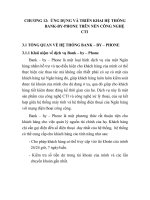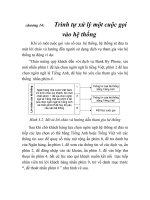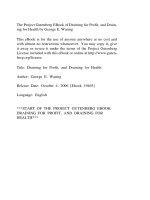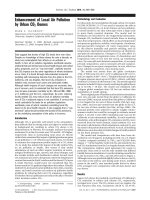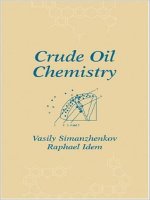Creative Chemistry, by Edwin E. Slosson docx
Bạn đang xem bản rút gọn của tài liệu. Xem và tải ngay bản đầy đủ của tài liệu tại đây (5.42 MB, 840 trang )
The Project
Gutenberg eBook,
Creative
Chemistry, by
Edwin E. Slosson
This eBook is for the use of anyone
anywhere at no cost and with
almost no restrictions whatsoever. You may
copy it, give it away or
re-use it under the terms of the Project
Gutenberg License included
with this eBook or online at
www.gutenberg.net
Title: Creative Chemistry
Descriptive of Recent Achievements in
the Chemical Industries
Author: Edwin E. Slosson
Release Date: November 24, 2005
[eBook #17149]
Language: English
Character set encoding: ISO-8859-1
***START OF THE PROJECT
GUTENBERG EBOOK CREATIVE
CHEMISTRY***
E-text prepared by Kevin
Handy, John Hagerson,
Josephine Paolucci,
and the Project Gutenberg
Online Distributed
Proofreading Team
( />
The Century Books of Useful
Science
CREATIVE
CHEMISTRY
DESCRIPTIVE OF
RECENT
ACHIEVEMENTS IN
THE CHEMICAL
INDUSTRIES
BY
EDWIN E. SLOSSON,
M.S., PH.D.
LITERARY EDITOR OF THE
INDEPENDENT, ASSOCIATE IN
COLUMBIA SCHOOL OF
JOURNALISM
Author of "Great American Universities,"
"Major Prophets of Today," "Six Major
Prophets," "On Acylhalogenamine
Derivatives and the Beckmann
Rearrangement," "Composition of Wyoming
Petroleum," etc.
WITH MANY ILLUSTRATIONS
NEW YORK
THE CENTURY CO.
Copyright, 1919, by
THE CENTURY CO.
Copyright, 1917, 1918, 1919, by
THE INDEPENDENT
CORPORATION
Published, October, 1919
THE PRODUCTION OF NEW AND
STRONGER FORMS OF STEEL IS
ONE OF THE GREATEST
TRIUMPHS OF MODERN
CHEMISTRY
The photograph shows the manufacture
of a 12-inch gun at the plant of the
Midvale Steel Company during the late
war. The gun tube, 41 feet long, has just
been drawn from the furnace where it
was tempered at white heat and is now
ready for quenching.
TO MY FIRST TEACHER
PROFESSOR E.H.S.
BAILEY
OF THE UNIVERSITY OF KANSAS
AND MY LAST TEACHER
PROFESSOR JULIUS
STIEGLITZ
OF THE UNIVERSITY OF CHICAGO
THIS VOLUME IS GRATEFULLY
DEDICATED
I
THREE PERIODS OF
PROGRESS
3
II NITROGEN
14
III FEEDING THE SOIL
37
IV COAL-TAR COLORS
60
V
SYNTHETIC PERFUMES
AND FLAVORS
93
VI CELLULOSE
110
VII SYNTHETIC PLASTICS
128
VIII THE RACE FOR RUBBER
145
IX THE RIVAL SUGARS
164
X WHAT COMES FROM CORN
181
XI SOLIDIFIED SUNSHINE
196
XII FIGHTING WITH FUMES
218
XIII
PRODUCTS OF THE
ELECTRIC FURNACE
236
XIVMETALS, OLD AND NEW
263
READING REFERENCES
297
INDEX
309
A CARD OF THANKS
This book originated in a series of articles
prepared for The Independent in 1917-18
for the purpose of interesting the general
reader in the recent achievements of
industrial chemistry and providing
supplementary reading for students of
chemistry in colleges and high schools. I
am indebted to Hamilton Holt, editor of
The Independent, and to Karl V.S.
Howland, its publisher, for stimulus and
opportunity to undertake the writing of
these pages and for the privilege of
reprinting them in this form.
In gathering the material for this volume I
have received the kindly aid of so many
companies and individuals that it is
impossible to thank them all but I must at
least mention as those to whom I am
especially grateful for information, advice
and criticism: Thomas H. Norton of the
Department of Commerce; Dr. Bernhard
C. Hesse; H.S. Bailey of the Department
of Agriculture; Professor Julius Stieglitz
of the University of Chicago; L.E. Edgar
of the Du Pont de Nemours Company;
Milton Whitney of the U.S. Bureau of
Soils; Dr. H.N. McCoy; K.F. Kellerman
of the Bureau of Plant Industry.
E.E.S.
LIST OF
ILLUSTRATIONS
The production of new and
stronger forms of steel is
one of the greatest triumphs
of modern chemistry
Frontispiece
FACING
PAGE
The hand grenades contain
potential chemical energy
capable of causing a vast
amount of destruction when
released
16
Women in a munition plant
engaged in the manufacture
of tri-nitro-toluol
17
A chemical reaction on a
large scale
32
Burning air in a Birkeland-
Eyde furnace at the DuPont
plant
33
A battery of Birkeland-
Eyde furnaces for the
fixation of nitrogen at the
DuPont plant
33
Fixing nitrogen by calcium
carbide
40
A barrow full of potash
salts extracted from six tons
of green kelp by the
government chemists
41
Nature's silent method of
nitrogen fixation
41
In order to secure a new
supply of potash salts the
United States Government
set up an experimental plant
at Sutherland, California,
for utilization of kelp
52
Overhead suction at the San
Diego wharf pumping kelp
from the barge to the
digestion tanks
53
The kelp harvester
gathering the seaweed from
the Pacific Ocean
53
A battery of Koppers by-
product coke-ovens at the
plant of the Bethlehem Steel
Company, Sparrows Point,
Maryland
60
In these mixing vats at the
Buffalo Works, aniline dyes
are prepared
61
A paper mill in action
120
Cellulose from wood pulp
is now made into a large
variety of useful articles of
which a few examples are
here pictured
121
Plantation rubber
160
Forest rubber
160
In making garden hose the
rubber is formed into a tube
by the machine on the right
and coiled on the table to
the left
161
The rival sugars
176
Interior of a sugar mill
showing the machinery for
crushing cane to extract the
juice
177
Vacuum pans of the
American Sugar Refinery
Company
177
Cotton seed oil as it is
squeezed from the seed by
the presses
200
Cotton seed oil as it comes
from the compressors
flowing out of the faucets
201
Splitting coconuts on the
island of Tahiti
216
The electric current passing
through salt water in these
cells decomposes the salt
into caustic soda and
chlorine gas
217
Germans starting a gas
attack on the Russian lines
224
Filling the cannisters of gas
masks with charcoal made
from fruit pits—Long Island
City
225
The chlorpicrin plant at the
Bdgewood Arsenal
234
Repairing the broken stern
post of the U.S.S. Northern
Pacific, the biggest marine
weld in the world
235
Making aloxite in the
electric furnaces by fusing
coke and bauxite
240
A block of carborundum
crystals
241
Making carborundum in the
electric furnace
241
Types of gas mask used by
America, the Allies and
Germany during the war
256
Pumping melted white
phosphorus into hand
grenades filled with water
—Edgewood Arsenal
257
Filling shell with "mustard
gas"
257
Photomicrographs showing
the structure of steel made
by Professor E.G. Mahin of
Purdue University
272
The microscopic structure
of metals
273
INTRODUCTION
BY JULIUS STIEGLITZ
Formerly President of the American
Chemical Society, Professor of
Chemistry in The University of Chicago
The recent war as never before in the
history of the world brought to the nations
of the earth a realization of the vital place
which the science of chemistry holds in
the development of the resources of a
nation. Some of the most picturesque
features of this awakening reached the
great public through the press. Thus, the

